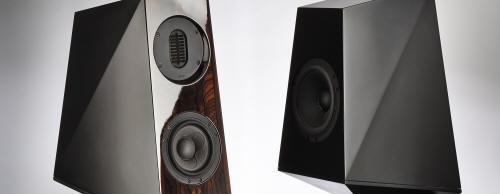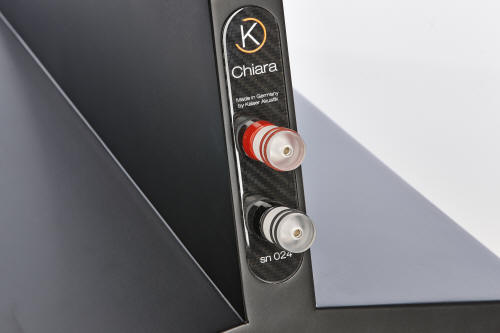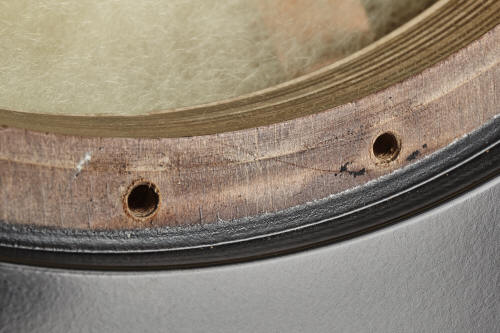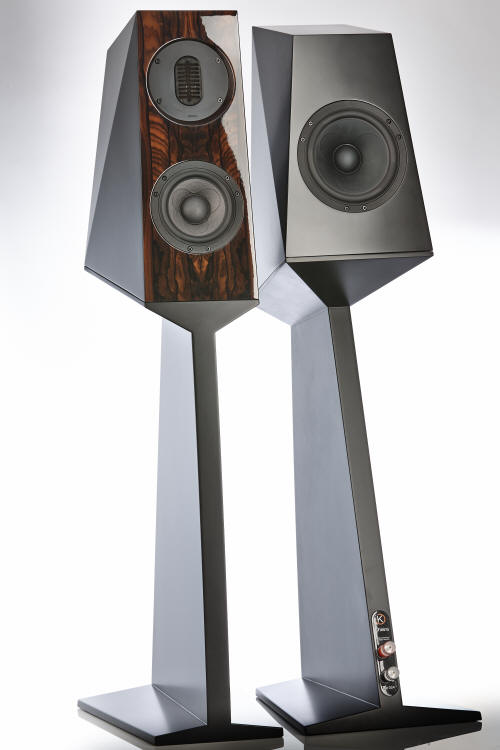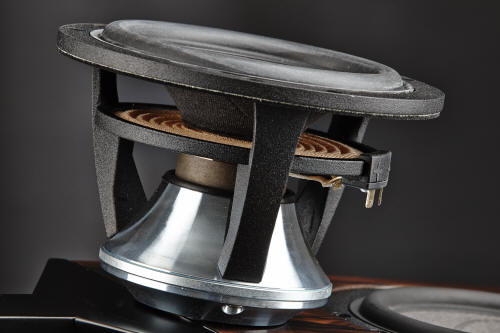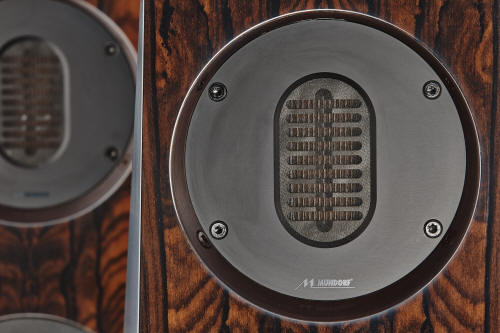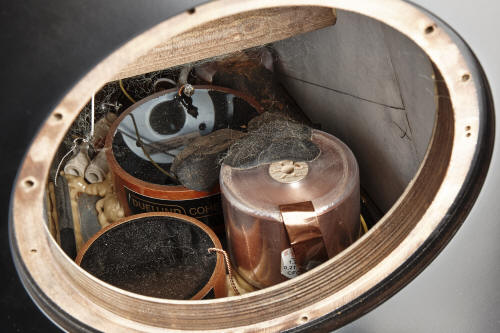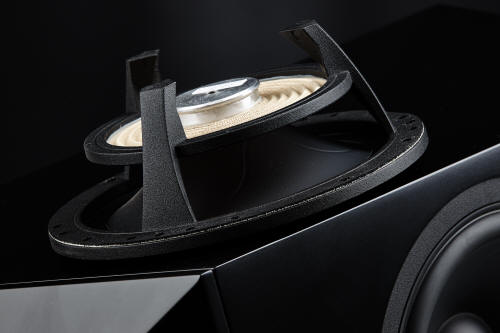|
|
You are reading the older HTML site
Positive Feedback ISSUE 73
kaiser kawero Chiara Loudspeakers as reviewed by Jurgen Saile
English translation of original German text from http://www.hifistatement.net/tests/item/1269-kaiser-kawero-chiara "Oh, those are cute!" I'm actually not used to hearing such statements from my better half; at least not regarding hi-fi. For me at least, the Chiara design actually seemed more like an american stealth jet. First impressions aside, this loudspeaker truly represents more than meets the eye. The fit and finish of the enclosures is the stuff of legend! An extra option for a full high gloss finish is also available. One can see here that for acoustical reasons the tweeter is not positioned exactly in parallel to the front face "Let's try them out" is what I heard next. Apparently the aural curiosity brought forth by the visual design was so great that I was suddenly handed a CD by Dusty Springfield, the English lady with the "afro-voice" which would have gone down well in any Motown production. She probably would have gladly sung for this label, but due to her white skin it would have been difficult in those days. So I put on The Windmills Of Your Mind. To put it lightly, the technical aspects of this recording are really no sensation. But the feeling that is conveyed is in fact very sensational. The seasoned reader among us who remembers this time period will likely relate to this. With the Chiara, the weaknesses of this recording don't reduce the pleasures of listening to the music. True, the mistakes are of course plainly obvious, but they don't diminish the pleasure of listening. One thing has become clear right from the start with this recording: the Chiara is an excellent reproducer of sonic images! What an impressive start! The Chiara comes delivered in a professional flight case. Standing it up vertically, one could probably use it as a walk-in closet. Well, almost. And let's not forget that the Chiara is merely the lightweight of the three available Kawero! loudspeakers. For the transportation of the largest model, called Classic, might it be wise to have available the contact information for four trained coffin carriers.
The binding posts are manufactured by Mundorf, they are not designed for bi-wiring. The loudspeaker's extraordinarily homogenous performance would probably not benefit from it First a few words about Kaiser Acoustics. This company has somehow been incredibly successful at keeping the name Kawero! secret from the german hi-fi scene. Why are they always flying under the radar... could it really be 'stealth' technology in action? Kaiser Acoustics is in no way a newcomer, but has been visibly operative in the realm of professional acoustics, optimizing studios and concert halls. For example, just as the Chiara was being delivered to us, the studios of the Bavarian Radio were being restructured. This company's factory, located in Untergriesbach, Germany, has highly advanced wood processing and shaping capabilities. They are not like a typical large carpenter's workshop, but a high tech facility which really can shape wood and wood-based materials into any imaginable 3D form possible. A conventional woodworking shop would quickly give up upon even a glance at the extravagant form of the Chiara. Of course, woodworking expertise alone, regardless of how precise it is carried out, isn't enough to elevate a loudspeaker to any higher than average. Technical development is therefore provided by another professional, Rainer Weber. (The first two letters of his last name make up the middle syllable of the portmanteau "Kawero!".) When one lifts the Chiara in order to place it, one must wonder where the little rascal gets all that weight from. The thing weighs in at 75 pounds! The explanation comes from Untergriesbach: the housing is manufactured from Panzerholz (tankwood). Not to be confused with the wood from the Panzerbaum tree (Arctostaphylos Saileii), in this case it is a wood-based artificial laminate material. Thin layers of beechwood are formed into a monolithic phenolic laminate board under great pressure and heat. The end result has only 60 percent of the original wood's thickness.
Panzerholz is so dense that it lends itself for threading to accept mounting bolts for the drivers. Metal bolts at that! Because of the high thread count, normal fibreboard (MDF) or plywood would simply strip right through The manufacturer calls it a Phenolic wood laminate/dense rubber/fiberglass sandwich. I can definitely vouch for the "dense" part. With this construction the material gains a strength similar to that of metal. A side effect of this is that the Chiara is practically bullet proof! Well, you never know. The form of the Chiara is not only meant to be an eye catcher, but is a purposely engineered solution to avoid parallel walls. In this way, standing waves within the housing are meant to be avoided. In addition, much thought and effort was put into separating vibration and resonance from the speaker drivers themselves. If one does this with damping material alone, one not only dampens the resonances, but loses acoustical energy as well. A better idea therefore would be to conduct or to drain the resonance similar to the way a lightning rod (arrester) drains the charge of a lightning bolt into the earth. The manufacturer constructed the speaker in such a way that the bulk of the resonance is drained into the stand's foot. Three acoustical labyrinths are integrated invisibly into the loudspeaker's foot. This technology was mutually developed between Kaiser Acoustics and Vertex AQ from England. This approach also results in less damping material being needed inside the housing itself. What at first glace appears to be a three way loudspeaker reveals itself upon closer inspection to be a two way system with added support for bass through a passive membrane. A passive membrane acts similar to a bass reflex port, but offers more flexibility for tuning and avoids airstream noise which can occur with reflex ports and high sound levels.
The Chiara is rich in invisible innovative technologies. But on first impression, one cannot deny the clearly obvious masterfully crafted fit and finish Kaiser did not skimp on the choice of drivers either and chose the top line of the danish manufacturer Scan-Speak. Scan-Speak has always made excellent drivers, even if presently the use of ceramic drivers happens to be "in". The 15 centimeter bass driver from the "Illuminator" series has a paper sandwich membrane and a neodymium magnet. The bass is set up as a long throw system and achieves a low resonance frequency of 34Hz. A great feature is the open and aerodynamic structure of the driver, a testament to Scan-Speak's dedication to quality. The bass is supported by an 18 centimeter passive membrane, also made by Scan-Speak, but made custom for Kaiser in this form and size. A drop of bitterness for a high efficiency fan such as myself: the Scan-Speak bass has a sensitivity of only 87dB. Highs are taken care of by a Mundorf air motion transformer. Based on a discovery by Oskar Heil, the AMT achieves higher sound pressure levels than a standard ribbon given the same membrane dimensions and movements due to its folded membrane structure. For the Chiara, Mundorf manufactures a special version of this driver according to custom specifications laid out by Kaiser.
The innovatively designed Scanspeak driver. The magnet is made of neodymium and can therefore be of smaller size while creating the same magnetic field strength Of significance to the sound quality is the construction of the crossover. This goes for the quality of its parts as well as the way they are put together. Weber chose capacitors, coils and resistors from Duelund of Denmark. These truly are members of the worldwide top elite performers, as well as in price. Only one coil in the circuit was chosen from Mundorf. An analogous part from Duelund would no longer have physically fit into the enclosure. Every loudspeaker designer approaches crossover schematic design in different ways. There are those who seek only a flat response, end of story. With a largish amount of circuitry, any given frequency performance curve can be straightened out. The question after such manipulation is of course how it ultimately sounds. Another approach is to maximize listening pleasure, even though it may be known that ruler-flat response is not achieved. Rainer Weber, designer of the Chiara, went another way altogether. Basing his design on his professional background with acoustical phenomena, his solution differs from that of many others. He managed to achieve a realistic imagery in size, even though the Chiara is small. It goes without saying that exact design specifics regarding this achievement remain proprietary. But it can be said that measurements he used included the use of a binaural head microphone system which closely emulates the human ear and its position within the organic human hearing mechanism. One of my favorite musicians is the spaniard Jodi Savall, who together with his wife Montserrat Figueras, son and daughter performs Du temps et de l'instant. The music chosen by Savall comes from all over the world, ranging from Afghanistan to Mexico. The first piece titled "Cantiga de amigo V" comes from the 13th century, by Martim Codax from Galicia. The CD is exceptionally recorded, something that becomes immediately apparent through the Chiara. Indeed, the reproduction of acoustical instruments seems to be a great strength of this loudspeaker. The theorbo that Ferran Savall uses here has a clearly different sound characteristic than a guitar, and not merely because of its lower range extension of notes. The same applies to the Viola da Gamba played by Jordi Savall. To differentiate these fine nuances of sound is no challenge for the Chiara. This goes for fantastic voice reproduction, too, in this case Montserrat Figueras. The depiction of the musical whole flows forth in a perfectly homogenous way. Earlier I mentioned the excellent sound staging of this speaker. In addition, it is astounding how the musicians are depicted in realistic size. This is often not the case with compact loudspeakers of this size. Scene change: Blues on Bach by The Modern Jazz Quartet. Before any hard core classical music fans among us turn up their noses, I'd like to emphasize that the concept here is very interesting. The idea is not to take melodies from Bach and to somehow mix them with jazz. On the contrary, John Lewis wanted to take other challenging forms and structures and integrate them with jazz. I know, that still probably won't impress the classical fans. "Kantate BWV 147 Jesu bleibet meine Freude" now obviously contains the handwriting of both Bach and the MJQ. Again we encounter the grandiose imaging capabilities of the Chiara. The instruments stand as three dimensional palpable objects in the room. The recording of the harpsichord is not as full of brilliant overtones and as fiery as one hears in other recordings. Sometimes it can sound rather artificial in this respect. The vibraphone was better recorded, one can definitely tell. The contrabass was recorded well and the Chiara depicts its body and many colors vividly. The whole of the sound does not sound like it is coming from "a box". All of this is very clearly audible through this loudspeaker. If you choose to pay attention to it. In general, the loudspeaker focuses one's attention towards the performance of the musicians. This is really the way it should be.
One can clearly see the folded diaphragm of the AMT tweeter. When in action, the motion is from like that of an accordion You can tell Kaiser didn't just throw expensive parts and rare materials together to achieve the desired price point. The construction is very well thought out and absolutely perfected. You can really feel the attention to detail in every aspect. Setting up the speaker, one should make efforts for proper placement. I achieved best focus and imaging when they were parallel to one another, or maybe just a tad toed in. Of course, your conditions will differ. When turned directly toward the listener, the highs become somewhat emphasized. The proportions of the musicians are well organized, and you never get the feeling you are sitting in front of a puppet theater. When you close your eyes, you really do believe you have a large standing loudspeaker in front of you. I have never experienced this with a loudspeaker of this size before. Don't expect miracles in the lowest bass region. After all there's a limit to what you can expect from a 15 cm bass driver. But the Chiara really rocks in my 40 square meter large room, no question about it! I had not expected this type of performance in a footprint so small. At first I ignored the manufacturer's power amp recommendation of 150 Watts. Somehow I imagined the owner of a large Krell amp who prefers the recordings of Yello. I don't know how long I would enjoy that. But regardless, my own Mayer 211 Elrog had absolutely no problem with the loudspeaker, and it can "only" do 25 Watts. It should be said, though, that the amp features an extremely potent power supply. A quick calculation will reveal that the Chiara under such conditions can produce a maximum sound pressure level of about 100 dB, which is equivalent for some heavy metal fans to a pleasant tinkling of background music. But they'd be in the market for something else anyway. In general, more power is never a mistake, as long as the amp can keep up in the realm of sound quality as well.
One look at the crossover's impressively exclusive parts, and one sees the dedication put into this loudspeaker. Duelund's pricey PIO-Cast caps are used, and the Mundorf coils are of a gigantic calibre. Taking into consideration the meticulous hands-on crafting of the enclosure and these noble components, it's obvious here that we're dealing with a creation without compromise, priced accordingly For the sake of completeness, I borrowed a 200 Watt transistor amplifier from the editorial office and connected it with the Chiara. To be honest, I could not pinpoint any advantage over the 211 Elrog. On the contrary, several disadvantages became obvious: resolution, clearness, dynamics and emotionality were all lacking. This may not apply to all 200 Watt amps, but the qualities of the Chiara are quite evident with the 211. Nevertheless, I could easily imagine good results using a tube amp of 50-70 Watts, probably of Push-Pull design. This loudspeaker can do things that I have never heard in this size. The playback is very clear, or, for want of a better term, purged. The mere thought of this would often lead to a belief that your relative portion of non-listenable music would increase exponentially. But this is not the case at all. The playback remains completely stress free and relaxed. The feeling of presence is never "in your face." All in all, I get the feeling that I associate with Sunday evenings when the power grid is less loaded and contains less interference. On such evenings, music sounds calmer, is more relaxed and clean. I can easily imagine that the sophisticated resonance draining technology is largely responsible for this effect. The housing has practically no self resonance and the back reflected sound emission from the bass driver has apparently little effect on the membrane from within.
The 18 centimeter passive diaphragm is almost a complete driver, just without the magnet. I cannot hear any transition between the AMT tweeter and the bass. It's a very well integrated transition. Some readers may remember the first ESS models with the original air motion transformer, where the bass could never keep up with the racing fast speed of the tweeter. Music flows out of the Chiara in a homogenous way. The advantages of small loudspeakers, namely the pinpoint precision of the stereo image, is blended in the Chiara with sovereign, mature sound quality. Whether on or off, this loudspeaker is really quite fascinating. It's also fascinating what this loudspeaker does with a recording such as Benny Goodman's Carnegie Hall Jazz Concert. This recording has no special audiophile traits. It was made in 1938! I know this recording by heart in both vinyl and CD versions, and in both cases, the imagery is as flat as a pancake and the sound colors all white as snow. The Chiara manages to pull the very best out and to make the music enjoyable. And it does this in the most exceptional way. The whole seems much more cleaned up and one believes for the first time to recognize a breath of structure. Because of the poor quality, this recording has been on the shelf for some time now. But in this recording, Goodman managed to collect almost all of the jazz greats of that time for this momentous concert. Jazz at that time was still considered widely to be something somewhat sketchy, so a concert in the famous Carnegie hall was truly an exceptional event. It is rumored that trumpeter Harry James said as he went on stage: "I feel like a whore in a church." Played through the Chiara, this milestone of the swing era is brought to new life. In closing let me paraphrase Loriot: A life without Chiara is of course possible, but not meaningful. Of course, as we all know, in the original he said pugs. Conclusion I confess frankly, I like the loudspeaker. If it didn't have its conspicuous form, it would be THE understated loudspeaker of all! And it's one of the most innovative for sure. It is unbelievable, which amount of performance Kaiser brings forth from this small loudspeaker. Jurgen Saile
Chiara Kaiser Kawero! Chiara
Kaiser GmbH Contact for private audition, available in the showroom in Regensburg
|









